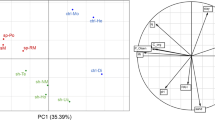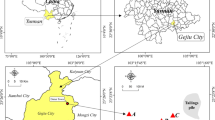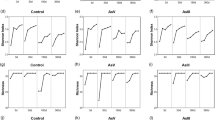Abstract
The impact of both organic and inorganic pollution on the structure of soil microbial communities is poorly documented. A short-time batch experiment (6 days) was conducted to study the impact of both types of pollutants on the taxonomic, metabolic and functional diversity of soil bacteria. For this purpose sand spiked with phenanthrene (500 mg kg−1 sand) or arsenic (arsenite 0.66 mM and arsenate 12.5 mM) was supplemented with artificial root exudates and was inoculated with bacteria originated from an aged PAH and heavy-metal-polluted soil. The bacterial community was characterised using bacterial strain isolation, TTGE fingerprinting and proteomics. Without pollutant, or with phenanthrene or arsenic, there were no significant differences in the abundance of bacteria and the communities were dominated by Pseudomonas and Paenibacillus genera. However, at the concentrations used, both phenanthrene or arsenic were toxic as shown by the decrease in mineralisation activities. Using community-level physiological profiles (Biolog Ecoplates™) or differential proteomics, we observed that the pollutants had an impact on the community physiology, in particular phenanthrene induced a general cellular stress response with changes in the central metabolism and membrane protein synthesis. Real-time PCR quantification of functional genes and transcripts revealed that arsenic induced the transcription of functional arsenic resistance and speciation genes (arsB, ACR3 and aioA), while no transcription of PAH-degradation genes (PAH-dioxygenase and catechol-dioxygenase) was detected with phenanthrene. Altogether, in our tested conditions, pollutants do not have a major effect on community abundance or taxonomic composition but rather have an impact on metabolic and functional bacterial properties.




Similar content being viewed by others
References
Achour AR, Bauda P, Billard P (2007) Diversity of arsenite transporter genes from arsenic-resistant soil bacteria. Res Microbiol 158:128–137
Andreoni V, Cavalca L, Rao MA, Nocerino G, Bernasconi S, Dell’Amico E, Colombo M, Gianfreda L (2004) Bacterial communities and enzyme activities of PAH polluted soils. Chemosphere 57:401–412
Avidano L, Gamalero E, Cossa GP, Carraro E (2005) Characterization of soil health in an Italian polluted site by using microorganisms as bioindicators. Appl Soil Ecol 30:21–33
Bååth E (1989) Effects of heavy metals in soil on microbial processes and populations (a review). Water Air Soil Pollut 47:335–379
Bachate SP, Khapare RM, Kodam KM (2012) Oxidation of arsenic by two beta-proteobacteria isolated from soil. Appl Microbiol Biotechnol 93:2135–2145
Bertin PN, Heinrich-Salmeron A, Pelletier E, Goulhen-Chollet F, Arsene-Ploeze F, Gallien S, Lauga B, Casiot C, Calteau A et al (2011) Metabolic diversity among main microorganisms inside an arsenic-rich ecosystem revealed by meta- and proteo-genomics. ISME J 5:1735–1747
Bringel F, Hammann P, Kugler V, Arsene-Ploeze F (2008) Lactobacillus plantarum response to inorganic carbon concentrations: PyrR(2)-dependent and -independent transcription regulation of genes involved in arginine and nucleotide metabolism. Microbiology 154:2629–2640
Bruneel O, Volant A, Gallien S, Chaumande B, Casiot C, Carapito C, Bardil A, Morin G, Brown GE, Personné CJ, Le Paslier D, Schaeffer C, Van Dorsselaer A, Bertin PN, Elbaz-Poulichet F, Arsène-Ploetze F (2011) Characterization of the active bacterial community involved in natural attenuation processes in arsenic-rich creek sediments. Microb Ecol 61:793–810
Cai L, Liu GH, Rensing C, Wang GJ (2009) Genes involved in arsenic transformation and resistance associated with different levels of arsenic-contaminated soils. BMC Microbiol 9:4
Cai L, Rensing C, Li XY, Wang GJ (2009) Novel gene clusters involved in arsenite oxidation and resistance in two arsenite oxidizers: Achromobacter sp. SY8 and Pseudomonas sp. TS44. Appl Microbiol Biotechnol 83:715–725
Campos VL, Valenzuela C, Yarza P, Kämpfer P, Vidal R, Zaror C, Mondaca MA, Lopez-Lopez A, Rosselló-Móra R (2010) Pseudomonas arsenicoxydans sp nov., an arsenite-oxidizing strain isolated from the Atacama desert. Syst Appl Microbiol 33:193–197
Cao B, Geng A, Loh KC (2008) Induction of ortho- and meta-cleavage pathways in Pseudomonas in biodegradation of high benzoate concentration: MS identification of catabolic enzymes. Appl Microbiol Biotechnol 81:99–107
Cavalca L, Zanchi R, Corsini A, Colombo M, Romagnoli C, Canzi E, Andreoni V (2010) Arsenic-resistant bacteria associated with roots of the wild Cirsium arvense (L.) plant from an arsenic polluted soil, and screening of potential plant growth-promoting characteristics. Syst Appl Microbiol 33:154–164
Cébron A, Norini MP, Beguiristain T, Leyval C (2008) Real-time PCR quantification of PAH-ring hydroxylating dioxygenase (PAH-RHDα) genes from Gram positive and Gram negative bacteria in soil and sediment samples. J Microbiol Methods 73:148–159
Cébron A, Beguiristain T, Faure P, Norini MP, Masfaraud JF, Leyval C (2009) Influence of vegetation on the in situ bacterial community and polycyclic aromatic hydrocarbon (PAH) degraders in aged PAH-contaminated or thermal-desorption-treated soil. Appl Environ Microbiol 75:6322–6330
Cébron A, Louvel B, Faure P, France-Lanord C, Chen Y, Murrell JC, Leyval C (2011) Root exudates modify bacterial diversity of phenanthrene degraders in PAH-polluted soil but not phenanthrene degradation rates. Environ Microbiol 13:722–736
Corsini A, Cavalca L, Crippa L, Zaccheo P, Andreoni V (2010) Impact of glucose on microbial community of a soil containing pyrite cinders: role of bacteria in arsenic mobilization under submerged condition. Soil Biol Biochem 42:699–707
Dennis PG, Miller AJ, Hirsch PR (2010) Are root exudates more important than other sources of rhizodeposits in structuring rhizosphere bacterial communities? FEMS Microb Ecol 72:313–327
El Azhari N, Devers-Lamrani M, Chatagnier G, Rouard N, Martin-Laurent F (2010) Molecular analysis of the catechol-degrading bacterial community in a coal wasteland heavily contaminated with PAHs. J Hazard Mater 177:593–601
Elias JE, Gygi SP (2007) Target-decoy search strategy for increased confidence in large scale protein identifications by mass spectrometry. Nat Methods 4:207–214
Felske A, Akkermans ADL, De Vos WM (1998) Quantification of 16S rRNAs in complex bacterial communities by multiple competitive reverse transcription PCR in temperature gradient gel electrophoresis fingerprints. Appl Environ Microbiol 64:4581–4587
Fierer N, Bradford MA, Jackson RB (2007) Toward an ecological classification of soil bacteria. Ecology 88:1354–1364
Fitz WJ, Wenzel WW (2002) Arsenic transformations in the soil–rhizosphere–plant system: fundamentals and potential application to phytoremediation. J Biotechnol 99:259–278
Griffiths BS, Ritz K, Ebblewhite N, Dobson G (1999) Soil microbial community structure: effects of substrate loading rates. Soil Biol Biochem 31:145–153
Guckert JB, Carr GJ, Johnson TD, Hamm BG, Davidson DH, Kumagai Y (1996) Community analysis by Biolog: curve integration for statistical analysis of activated sludge microbial habitats. J Microbiol Methods 27:183–197
Halter D, Cordi A, Gribaldo S, Gallien S, Goulhen-Chollet F, Heinrich-Salmeron A, Carapito C, Pagnout C, Montaut D, Seby F, VanDorsselaer A, Schaeffer C, Bertin PN, Bauda P, Arsene-Ploeze F (2011) Taxonomic and functional prokaryote diversity in mildy arsenic-contaminated sediments. Res Microbiol 162:877–887
Haritash AK, Kaushik CP (2009) Biodegradation aspects of polycyclic aromatic hydrocarbons (PAHs). J Hazard Mat 169:1–15
Harwood CS, Parales RE (1996) The beta-ketoadipate pathway and the biology of self-identity. Ann Rev Microbiol 50:553–590
Heinrich-Salmeron A, Cordi A, Brochier-Armanet C, Halter D, Pagnout C, Abbaszadeh-fard E, Montaut D, Seby F, Bertin PN, Bauda P, Arsène-Ploetze F (2011) Unsuspected diversity of arsenite-oxidizing bacteria as revealed by widespread distribution of the aoxB gene in prokaryotes. Appl Environ Microbiol 77:4685–4692
Jiang W, Wang J, Tang J, Hou F, Lu Y (2010) Soil bacterial functional diversity as influenced by cadmium, phenanthrene and degrade bacteria application. Environ Earth Sci 59:1717–1722
Johnsen AR, Wick LY, Harms H (2005) Principles of microbial PAH-degradation in soil. Environ Pollut 133:71–84
Kozdrój J, van Elsas JD (2000) Response of the bacterial community to root exudates in soil polluted with heavy metals assessed by molecular and cultural approaches. Soil Biol Biochem 32:1405–1417
Kruger MC, Bertin PN, Heipieper HJ, Arsène-Ploetze F (2013) Bacterial metabolism of environmental arsenic-mechanisms and biotechnological applications. Appl Microbiol Biotechnol 97:3827–3841
Lami R, Jones LC, Cottrell MT, Lafferty BJ, Ginder-Vogel M, Sparks DL, Kirchman DL (2013) Arsenite modifies structure of soil microbial communities and arsenite oxidization potential. FEMS Microbiol Ecol 84:270–279
Liao VH, Chu Y, Su Y, Hsiao S, Wei C, Liu C, Liao C, Chen W, Chang F (2011) Arsenite-oxidizing and arsenate-reducing bacteria associated with arsenic-rich groundwater in Taiwan. J Contam Hydrol 123:20–29
Lindhal V, Bakken LR (1995) Evaluation of methods for extraction of bacteria from soil. FEMS Microb Ecol 16:135–142
Louvel B, Cébron A, Leyval C (2011) Root exudates affect phenanthrene biodegradation, bacterial community and functional gene expression in sand microcosms. Int Biodeter Biodegr 65:947–953
Ma Y, Wang L, Shao Z (2006) Pseudomonas, the dominant polycyclic aromatic hydrocarbon-degrading bacteria isolated from Antartic soils and the role of large plasmids in horizontal gene transfer. Environ Microbiol 8:455–465
Macur RE, Jackson CR, Botero LM, McDermott TR, Inskeep WP (2004) Bacterial populations associated with the oxidation and reduction of arsenic in an unsaturated soil. Environ Sci Technol 38:104–111
Ouvrard S, Barnier C, Bauda P, Beguiristain T, Biache C, Bonnard M, Caupert C, Cébron A, Cortet J, Cotelle S, Dazy M, Faure P, Masfaraud JF, Nahmani J, Palais F, Poupin P, Raoult N, Vasseur P, Morel JL, Leyval C (2011) In situ assessment of phytotechnologies for multicontaminated soil management. Int J Phytorem 13:245–263
Pepi M, Heipieper HJ, Fischer J, Ruta M, Volterrani M, Focardi SE (2008) Membrane fatty acids adaptative profile in the simultaneous presence of arsenic and toluene in Bacillus sp. ORAs2 and Pseudomonas sp. ORAs5 strains. Extremophiles 12:343–349
Pepi M, Lobianco A, Renzi M, Perra G, Bernardini E, Marvasi M, Gasperini S, Volterrani M, Franchi E, Heipieper HJ, Focardi SE (2009) Two naphthalene degrading bacteria belonging to the genera Paenibacillus and Pseudomonas isolated from a highly polluted lagoon perform different sensitivities to the organic and heavy metal contaminants. Extremophiles 13:839–848
Poirel J, Joulian C, Leyval C, Billard P (2013) Arsenite-induced changes in abundance and expression of arsenite transporter and arsenite oxidase genes of a soil microbial community. Res Microbiol 164:457–465
Quantin C, Joner EJ, Portal JM, Berthelin J (2005) PAH dissipation in a contaminated river sediment under oxic and anoxic conditions. Environ Pollut 134:315–322
Quéméneur M, Cébron A, Billard P, Battaglia-Brunet F, Garrido F, Leyval C, Joulian C (2010) Population structure and abundance of arsenic-oxidizing bacteria along an arsenic pollution gradient in waters of the upper isle River basin, France. Appl Environ Microbiol 76:4566–4570
Rentz JA, Alvarez PJJ, Schnoor JL (2004) Repression of Pseudomonas putida phenanthrene-degrading activity by plant root extracts and exudates. Environ Microbiol 6:574–583
Rhine ED, Garcia-Dominguez E, Phelps CD, Young LY (2005) Environmental microbes can speciate and cycle arsenic. Environ Sci Technol 39:9569–9573
Sei K, Asano KI, Tateishi N, Mori K, Ike M, Fujita M (1999) Design of PCR primers and gene probes for the general detection of bacterial populations capable of degrading aromatic compounds via catechol cleavage pathways. J Biosci Bioeng 88:542–550
Siciliano SD, Germida JJ (1998) Mechanisms of phytoremediation: biochemical and ecological interactions between plants and bacteria. Environ Rev 6:65–79
Siggins A, Gunnigle E, Abram F (2012) Exploring mixed microbial community functioning: recent advances in metaproteomics. FEMS Microb Ecol 80:265–280
Singh BK, Millard P, Whiteley AS, Murrell JC (2004) Unravelling rhizosphere–microbial interactions: opportunities and limitations. Trends Microbiol 12:386–393
Smit E, Leeflang P, Gommans S, van den Broek J, van Mil S, Wernars K (2001) Diversity and seasonal fluctuations of the dominant members of the bacterial soil community in a wheat field as determined by cultivation and molecular methods. Appl Environ Microbiol 67:2284–2291
Springael D, Top EM (2004) Horizontal gene transfer and microbial adaptation to xenobiotics: new types of mobile genetic elements and lessons from ecological studies. Trends Microbiol 12:53–58
Su YH, Yang XY (2009) Interactions between selected PAHs and the microbial community in rhizosphere of a paddy soil. Sci Total Environ 407:1027–1034
Sun M, Fu D, Teng Y, Shen Y, Luo Y, Li Z, Christie P (2011) In situ phytoremediation of PAH-contaminated soil by intercropping alfalfa (Medicago sativa L.) with tall fescue (Festuca arundinacea Schreb.) and associated soil microbial activity. J Soils Sediments 11:980–989
Toledo FL, Calvo C, Rodelas B, Gonzalez-Lopez J (2006) Selection and identification of bacteria isolated from waste crude oil with polycyclic aromatic hydrocarbons removal capacities. Syst Appl Microbiol 29:244–252
Turpeinen R, Kairesalo T, Häggblom MM (2004) Microbial community structure and activity in arsenic-, chromium- and copper-contaminated soils. FEMS Microb Ecol 47:39–50
Verrhiest GJ, Clément B, Volat B, Montuelle B, Perrodin Y (2002) Interactions between a polycyclic aromatic hydrocarbon mixture and the microbial communities in a natural freshwater sediment. Chemosphere 46:187–196
Wang Q, He M, Wang Y (2011) Influence of combined pollution of antimony and arsenic on culturable soil microbial populations and enzyme activities. Ecotoxicology 20:9–19
Wang X, Rathinasabapathi B, de Oliveira LM, Guilherme LR, Ma LQ (2012) Bacteria-mediated arsenic oxidation and reduction in the growth media of arsenic hyperaccumulator Pteris vittata. Environ Sci Technol 46:11259–66
Weber KP, Grove JA, Geher M, Anderson WA, Legge RL (2007) Data transformations in the analysis of community-level substrate utilization data from microplates. J Microbiol Methods 69:461–469
Weiss S, Carapito C, Cleiss J, Koechler S, Turlin E, Coppee JY, Heymann M, Kugler V, Stauffert M, Cruveiller S, Médigue C, Van Dorsselaer A, Bertin PN, Arsène-Ploetze F (2009) Enhanced structural and functional genome elucidation of the arsenite-oxidizing strain Herminiimonas arsenicoxydans by proteomics data. Biochimie 91:192–203
Xiong J, Wu L, Tu S, Van Nostrand JD, He Z, Zhou J, Wang G (2010) Microbial communities and functional genes associated with soil arsenic contamination and the rhizosphere of the arsenic-hyperaccumulating plant Pteris vittata L. Appl Environ Microbiol 76:7277–7284
Yrjälä K, Keskinen AK, Akerman ML, Fortelius C, Sipilä TP (2010) The rhizosphere and PAH amendment mediate impacts on functional and structural bacterial diversity in sandy peat soil. Environ Pollut 158:1680–1688
Zhou HW, Wong AHY, Yu RMK, Park YD, Wong YS, Tam NFY (2009) Polycyclic aromatic hydrocarbon-induced structural shift of bacterial communities in mangrove sediment. Microb Ecol 58:153–160
Acknowledgment
We gratefully acknowledge the ANR program (MULTIPOLSITE, ANR-2008-CESA-010) for financial support, the Agence de l’Environnement et de la Maîtrise de l’Energie (ADEME) and the Bureau de Recherches Géologiques et Minières (BRGM) for J. Poirel PhD grant funding.
Author information
Authors and Affiliations
Corresponding author
Electronic supplementary material
Below is the link to the electronic supplementary material.
ESM 1
(DOC 59 kb)
Rights and permissions
About this article
Cite this article
Cébron, A., Arsène-Ploetze, F., Bauda, P. et al. Rapid Impact of Phenanthrene and Arsenic on Bacterial Community Structure and Activities in Sand Batches. Microb Ecol 67, 129–144 (2014). https://doi.org/10.1007/s00248-013-0313-1
Received:
Accepted:
Published:
Issue Date:
DOI: https://doi.org/10.1007/s00248-013-0313-1




